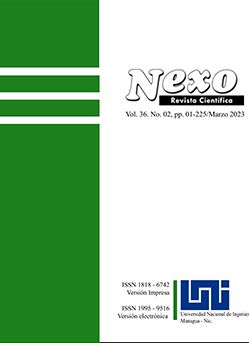Statistical analysis and machine learning in psychoactive substance use: a bibliometric analysis
DOI:
https://doi.org/10.5377/nexo.v36i02.16017Keywords:
Bibliometric analysis, statistical analysis, machine learning, psychotropic drugs, mental healthAbstract
Because psychoactive substance use is a topic that has received worldwide attention, this area has added several scientific outcomes. It is essential to conduct a comprehensive analysis comprising as many studies as are available to summarize the separate studies and provide an overall view of how the research field has been evolving over the last few decades. This paper performs a bibliometric analysis using a large dataset of published papers from 2000 to 2021. The study examined 1022 publications from those 20 years. About 79% used statistical analyses, and machine learning techniques were utilized by almost 21%. It is worth mentioning that the publications related to statistical analysis were grouped in the following way: multivariate or univariate statistical analysis (52.4%), Bayesian analysis (21.7%), and spatial analysis (50.5%). There were several key points regarding the overall results of the research. Results illustrated that publications had grown significantly during the last two decades. The majority of the publications come from the United States. In addition, the most prolific authors and journals were identified. Over the last decade, due to advanced technological methods, more research has been focused on enhancing and designing Bayesian techniques for using psychoactive substances.
Downloads
1769
Downloads
Published
How to Cite
Issue
Section
License
Copyright (c) 2023 Universidad Nacional de Ingeniería

This work is licensed under a Creative Commons Attribution 4.0 International License.
The authors who publish in Nexo Scientific Journal agree to the following terms:
- Authors retain the copyright and grant the journal the right of the first publication under the license Creative Commons Attribution License, which allows others to share the work with a recognition of the authorship of the work and the initial publication in Nexo Scientific Journal.
- Authors may separately establish additional agreements for the non-exclusive distribution of the version of the work published in the journal (for example, in an institutional repository or a book), with the recognition of the initial publication in Nexo Scientific Journal.
- Authors are allowed and encouraged to disseminate their works electronically (for example, in institutional repositories or in their own website) before and during the submission process, as it can lead to productive exchanges, as well as earlier and greater citation of published works.







